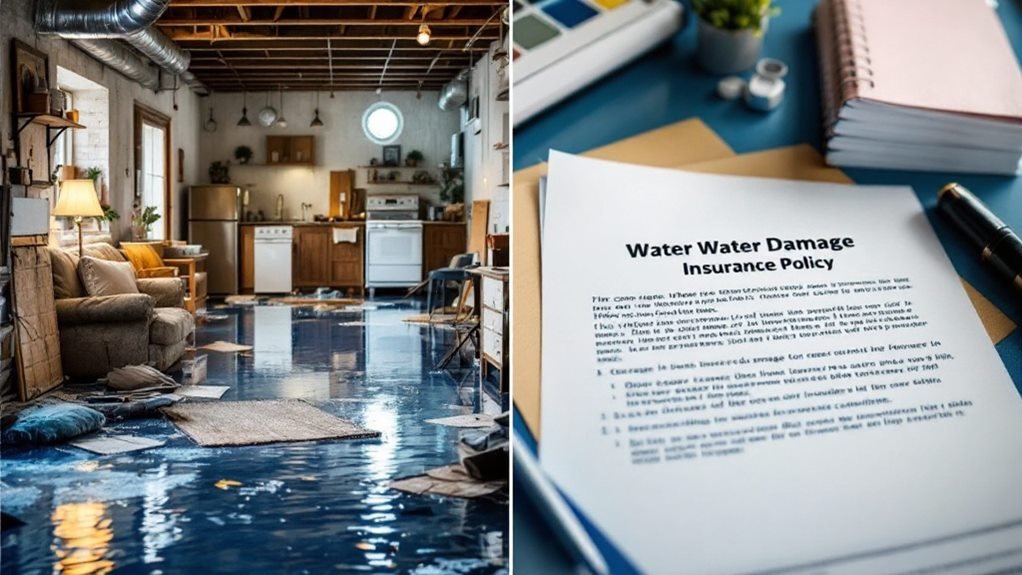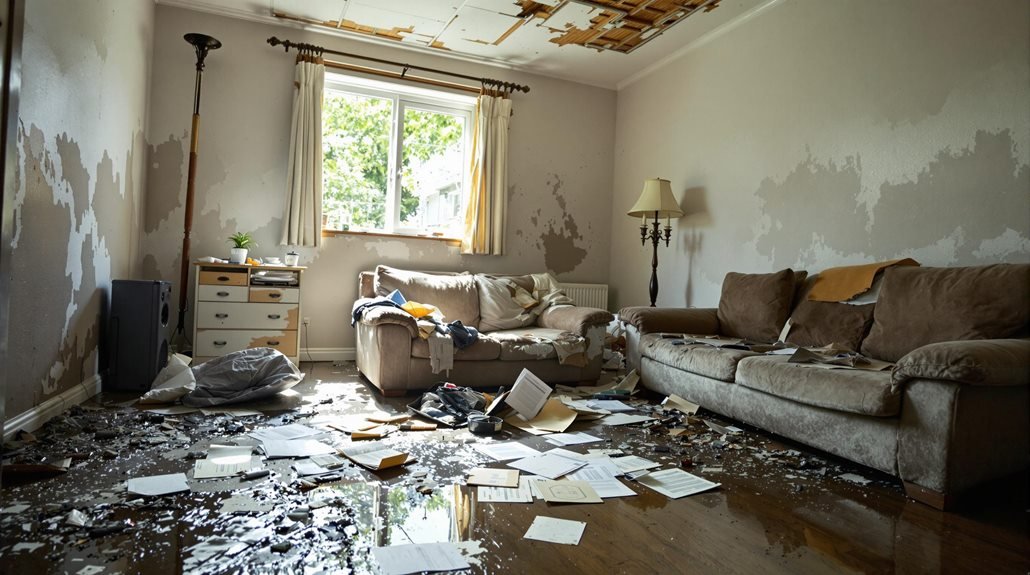Just like Odysseus faced unexpected storms on his journey home, you might find yourself maneuvering the complexities of water damage insurance. It's essential to understand what your policy actually covers and what it doesn't, especially since standard coverage often leaves significant gaps. Are you aware of the common exclusions that could leave you unprotected? Knowing the ins and outs of your coverage can make all the difference when disaster strikes, so let's investigate how you can better safeguard your home and finances in the face of water damage.
Types of Water Damage Coverage

When it comes to safeguarding your property, understanding the types of water damage coverage available is essential. You've got a couple of options, and knowing them can save you from a soggy situation. First up is the standard homeowners insurance policy, which typically covers sudden and accidental water damage—think burst pipes or a freak rainstorm that turns your living room into a wading pool.
On the flip side, you've got flood insurance, which is a must if you live in a flood-prone area. This type of coverage is specifically designed for those unforeseen deluges that make you feel like you've signed up for a water park ride, minus the fun.
Now, let's talk about those pesky insurance premium adjustments. If you've had to call in the pros for water damage restoration, your premiums might take a little hike. But don't panic; the right coverage can help mitigate those costs. Just keep an eye on your policy and review it regularly. After all, you don't want to be left paddling in the deep end without a life raft!
Common Policy Exclusions
When reviewing your water damage coverage, it's essential to understand common policy exclusions that could leave you vulnerable. Many standard policies don't cover flood damage, and you may likewise face limitations related to maintenance negligence and sewer backups. Knowing these exclusions helps you make knowledgeable choices about your insurance needs.
Flood Damage Exclusions
Flood damage exclusions in insurance policies can often leave homeowners feeling vulnerable and confused. If you live in a flood zone, you might find it particularly frustrating when your standard policy doesn't cover the very thing that keeps you up at night—water rising faster than your hopes of staying dry. Most standard homeowners insurance policies exclude flood damage, which means you'll need separate flood insurance if you want coverage. Sure, it sounds like a great way to rack up those insurance premiums, but it's likewise your lifeline when the downpour turns into a deluge.
You may think, "I'm protected from all water damage!" Well, not so fast! Typical exclusions include damage from overflowing rivers, flash floods, or even heavy rain if your property's not equipped. And don't get me started on how your insurance company might classify your home as "high risk" simply for being within a flood zone. So, check your policy carefully! You don't want to realize during a flood that your coverage is about as useful as a chocolate teapot. Understanding these exclusions is crucial to safeguarding your home and your sanity.
Maintenance Negligence Issues
After grappling with flood damage exclusions, it's important to recognize another common pitfall in insurance policies: maintenance negligence issues. Your insurance might not cover water damage if it's deemed that you've neglected your maintenance responsibilities. Think of it this way—if you ignore that leaky faucet until it becomes a mini Niagara Falls, don't expect your insurer to pick up the bill!
Here's a handy table to help you visualize some common maintenance negligence scenarios and their potential consequences:
| Negligence Issue | Example | Negligence Consequence |
|---|---|---|
| Roof Damage | Missing shingles | Water leaks into your living room |
| Clogged Gutters | Overflowing rainwater | Foundation issues and mold growth |
| Broken Pipes | Not repairing a small leak | Massive water damage and high costs |
Insurance companies often want to see that you've taken reasonable steps to maintain your property. So, if you can avoid looking like a water-damaged Picasso, do your part! Regular checks and repairs can save you from a world of financial hurt when the next storm rolls in.
Sewer Backup Limitations
Sewer backups can create a messy and costly situation, yet many homeowners are caught off-guard by their insurance policies' exclusions regarding this issue. You might think your insurance claims will cover that unpleasant surprise when your toilet decides to play the role of a fountain; nevertheless, you may be in for a rude awakening.
Most standard homeowners' policies don't cover sewer backups unless you specifically add that coverage. So, if you're relying on your insurance to rescue you from a bubbling toilet disaster, you could be in for disappointment. Imagine finding out the hard way that your policy treats sewer backups like a bad joke—everyone's laughing, but you're left holding the mess!
Additionally, even though you do add sewer backup coverage, there are often limits on the amount you can claim. It's vital to read the fine print, since what feels like a safety net might just be a decorative throw.
To avoid being the punchline of an insurance joke, talk to your agent about adding this coverage. After all, it's better to be safe than sorry when it comes to your home and your sanity!
Understanding Policy Limits

When reviewing your insurance policy, it's vital to grasp the limits of coverage for water damage, as these limits define how much compensation you can receive in the event of a claim. Think of policy limits as the bouncer at a club—no matter how much you want to party, they're the ones who decide if you're in or out.
Understanding policy terminology is significant here. Coverage limits typically come in two flavors: actual cash value and replacement cost. Actual cash value deducts depreciation, meaning if your beloved vintage carpet meets a watery demise, you might get less than you expect. Replacement cost, on the other hand, gives you enough cash to buy a brand-new version.
Now, let's talk coverage nuances. Some policies have separate limits for specific types of water damage, like flooding or sewer backups, which can feel like a surprise party you didn't want. It's important to know these details to avoid potential heartache when your basement turns into a swimming pool. So, read your policy carefully—your future self might just thank you for it!
Filing a Water Damage Claim
Knowing your policy limits is only the first step; filing a water damage claim requires careful attention to detail. You've got to gather your claim documentation like it's a scavenger hunt, but without the fun prizes. Start by snapping photos of the damage. Remember, blurry pictures of soggy carpets won't win you any awards, so keep your phone steady!
Next, list all the damaged items and their value. This isn't a guessing game—accurate figures can make or break your claim. Once you've got your evidence, it's time to formally file your claim with your insurance company. They'll assign you an insurance adjuster, who'll practically be your new best friend—if "best friend" means someone who inspects your home for water damage while you nervously sip coffee.
Expect to provide your adjuster with all that glorious claim documentation. They'll assess the damage and help determine what's covered. Remember, patience is key here; claims can take time, but staying organized will make the process smoother. And who knows? You might even have a good story to tell when it's all said and done!
Tips for Preventing Water Damage

Preventing water damage starts with being proactive about your home's maintenance. You wouldn't wait for a flat tire to check your car's air pressure, right? Regular inspections of your plumbing and roof can save you from the headache of unexpected leaks.
Here's a quick checklist to keep handy:
| Task | Frequency |
|---|---|
| Inspect Roof | Twice a year |
| Check Plumbing | Every six months |
| Clean Gutters | At least once a year |
In addition to regular inspections, having a solid emergency preparedness plan is vital. Make certain you know where your main water shut-off valve is; it's not just a fancy decoration! Have a list of emergency contacts, including your local plumber, on hand. And if you've got a basement, consider a sump pump—your home's personal lifeguard.
Reviewing Your Insurance Policy
When reviewing your insurance policy, you'll want to focus on the types of coverage it provides for water damage. Pay close attention to any exclusions and limitations that could affect your claim. Understanding the claim process is also essential, as it will guide you in maneuvering any potential issues when you need to file.
Policy Coverage Types
Understanding the nuances of your insurance coverage is crucial for effectively managing water damage claims. When you're knee-deep in water damage restoration, the last thing you want is to realize your policy doesn't cover what you thought it did. That's where understanding policy coverage types comes into play.
Here's a quick comparison to help you navigate the waters:
| Coverage Type | Description |
|---|---|
| Actual Cash Value | Covers the item's depreciated value. |
| Replacement Cost | Covers the cost to replace items. |
| Limited Coverage | Offers specific coverage for particular damages. |
| Broad Form Coverage | Covers a wider range of risks. |
| Special Form Coverage | Covers all risks unless specifically excluded. |
Exclusions and Limitations
Steering through your insurance policy's exclusions and limitations is essential to avoid unpleasant surprises during a water damage claim. When you think you're covered for water damage restoration, you might want to double-check. Some policies exclude specific types of water damage, like flooding or sewer backups—yes, the joys of homeownership!
In your insurance policy comparison, look for phrases like "not covered" and "limited to" lurking in the fine print. These exclusions can turn your dreams of a smooth restoration into a nightmare, leaving you high and dry—literally! For instance, if your basement floods because of a lack of maintenance, your insurer might shrug and say, "Not our problem."
Additionally, some policies impose limits on coverage amounts for certain types of damage. If your home suffers from extensive water damage, you don't want to find out the hard way that your cap is lower than your repair bills. So, grab your magnifying glass and read those exclusions carefully. Knowing them could save you from spending a fortune out-of-pocket when you thought your insurance was a financial life raft.
Claim Process Overview
Before diving into the claim process, reviewing your insurance policy is crucial. You need to decipher all that insurance terminology—it's like trying to read hieroglyphics without a Rosetta Stone. Familiarize yourself with your coverage, limits, and any exclusions related to water damage. Knowing what's covered can save you from that sinking feeling when filing a claim.
Here's a handy table to help you navigate the key components of your policy:
| Coverage Type | Details | Limitations |
|---|---|---|
| Dwelling Coverage | Protects your home structure from water damage | Usually excludes flood-related incidents |
| Personal Property | Covers your belongings affected by water damage | May have limits on high-value items |
| Additional Living | Covers temporary living expenses if your home's uninhabitable | Limited duration of coverage |
| Liability Coverage | Protects against claims if someone gets hurt on your property | Specific exclusions may apply |
| Deductible | The amount you pay out-of-pocket before insurance kicks in | Higher deductibles mean lower premiums |
Frequently Asked Questions
Does My Coverage Vary Based on the Type of Water Source?
Yes, your coverage does vary based on the water source. Flood insurance typically covers rising water, while sewer backup may require separate coverage. It's like picking your favorite toppings—each option affects your final dish!
Can I Add Additional Coverage for Water Damage?
Isn't it ironic how you can't dodge water damage but can add coverage? You can typically increase your limits, but don't forget to check your flood insurance options; they might just save you from drowning financially!
How Do I Find My Policy's Specific Water Damage Terms?
To find your policy's specific water damage terms, read the policy language closely. Look for coverage exclusions that might dampen your enthusiasm. If it feels overwhelming, don't hesitate to ask your agent for clarification!
Will My Premium Increase After a Water Damage Claim?
If you file a water damage claim, your premium might increase. Insurers consider premium factors like claim frequency; too many claims could raise your rates. So, keep a bucket handy and avoid frequent splashes!
Are Temporary Repairs Covered Before Filing a Claim?
You're probably wondering if those temporary repair guidelines are covered before filing an insurance claim. Typically, they can be, but check your policy first—because nothing's worse than a surprise when you're already dealing with water woes!
Conclusion
To summarize, understanding your insurance coverage for water damage is essential for protecting your home. You might think that your current policy covers everything, but many homeowners uncover gaps when it's too late. By proactively reviewing your policy and addressing exclusions, you can secure extensive protection. Remember, taking preventative measures now not only saves you money in the long run but additionally provides peace of mind, ensuring you're ready for any unexpected water damage that may arise.


Recent Comments